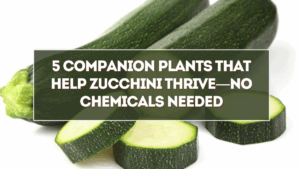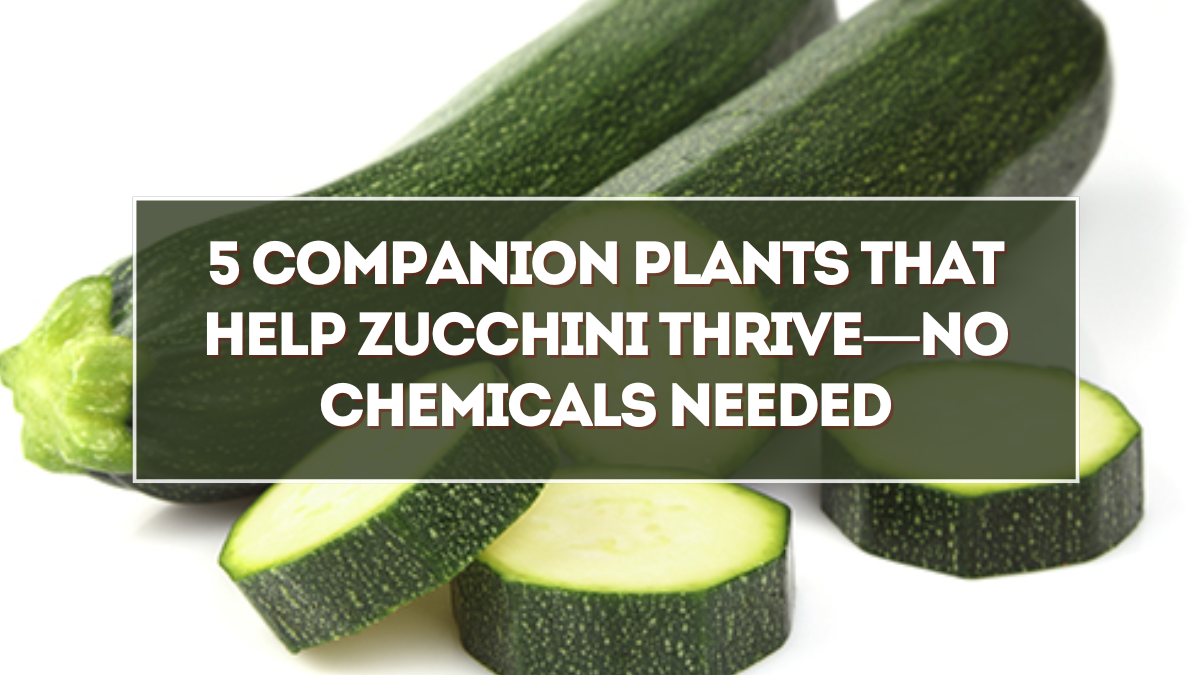Zucchini is one of the easiest vegetables to grow, but anyone who has planted it knows the challenges. Powdery mildew, squash bugs, and poor pollination can all reduce yields. Instead of reaching for chemical sprays, you can solve many of these problems by using companion plants for zucchini. By strategically pairing zucchini with herbs, flowers, and vegetables, you create a natural ecosystem where pests are deterred, pollinators are attracted, and soil fertility improves.
This guide explores five of the best companions—nasturtium, marigold, beans, oregano, and pollinator-friendly flowers—that boost zucchini growth and help your garden thrive without chemicals.

Why Companion Planting Works for Zucchini
Zucchini plants are vigorous growers with large leaves that can shade out nearby plants. However, they also have specific weaknesses:
-
Susceptible to pests such as squash bugs, cucumber beetles, and aphids.
-
Prone to diseases like powdery mildew in humid conditions.
-
Reliant on pollinators for fruit set.
Companion planting addresses these weaknesses by:
-
Repelling harmful insects with strong scents.
-
Attracting pollinators like bees and butterflies.
-
Improving soil fertility with nitrogen-fixing plants.
-
Saving space by creating a multi-layered planting system.
1. Nasturtium: The Trap Crop Protector
Nasturtium is a flowering plant that acts as a trap crop for pests. Its bright flowers lure aphids, cucumber beetles, and squash bugs away from zucchini.
Benefits:
-
Attracts beneficial insects like ladybugs and hoverflies that prey on pests.
-
Edible leaves and flowers add beauty and flavor to the garden.
-
Acts as a groundcover, reducing weeds and conserving soil moisture.
How to plant: Sow nasturtiums along the edges of zucchini beds. They’ll sprawl out, attracting pests while keeping the main crop safe.
2. Marigold: Natural Pest Control
Marigolds are legendary in companion planting. Their strong scent repels nematodes, aphids, and beetles that often attack zucchini.
Benefits:
-
Deters harmful soil pests like root-knot nematodes.
-
Attracts pollinators with bright flowers.
-
Provides continuous blooms through the season.
How to plant: Interplant marigolds between zucchini plants or in surrounding rows for maximum pest-repelling effect.
3. Beans: The Nitrogen Boosters
Zucchini is a heavy feeder, demanding lots of nutrients to fuel its rapid growth and high yields. Beans, being legumes, fix nitrogen in the soil through a symbiotic relationship with bacteria.
Benefits:
-
Naturally enriches soil with nitrogen, reducing fertilizer needs.
-
Improves zucchini vigor and leaf health.
-
Provides an edible crop alongside zucchini.
How to plant: Sow bush beans nearby or use pole beans on trellises next to zucchini beds. The beans enrich soil while zucchini shades the ground.
4. Oregano: The Aromatic Bodyguard
Oregano is a perennial herb with a strong aroma that confuses pests like cucumber beetles and squash bugs. It also attracts pollinators when in bloom.
Benefits:
-
Acts as a living mulch, shading the soil and reducing evaporation.
-
Repels harmful insects with its fragrance.
-
Provides culinary herbs for the kitchen.
How to plant: Place oregano at the corners of zucchini beds. It will spread gradually, offering protection and ground coverage.
5. Pollinator-Friendly Flowers
Since zucchini requires pollination for fruiting, attracting bees and butterflies is critical. Flowers like sunflowers, zinnias, and cosmos bring pollinators directly to the garden.
Benefits:
-
Boosts fruit set and yield.
-
Creates a more vibrant, diverse garden.
-
Provides nectar sources for bees, supporting local ecosystems.
How to plant: Add tall flowers like sunflowers behind zucchini beds and scatter smaller blooms like zinnias in between rows.
How to Arrange Companion Plants
A successful companion planting layout balances space, sunlight, and plant needs.
-
Plant zucchini in the center as the main crop.
-
Surround with nasturtium and marigolds at the edges.
-
Add bush beans in nearby rows or trellised pole beans.
-
Place oregano at corners for pest protection.
-
Mix in pollinator flowers for diversity and beauty.
This arrangement creates a supportive ecosystem where every plant plays a role in protecting and enhancing zucchini.
Mistakes to Avoid
-
Overcrowding: Zucchini leaves spread wide, so allow at least 2–3 feet of space between plants.
-
Wrong companions: Avoid planting zucchini near potatoes, as they compete for nutrients and attract overlapping pests.
-
Ignoring airflow: Dense planting can trap humidity and increase powdery mildew risk.
-
Over-relying on flowers alone: Flowers attract pollinators but don’t replace the need for balanced soil nutrition.
Step-by-Step Companion Planting Plan for Zucchini
-
Prepare the bed with compost and organic matter for fertility.
-
Plant zucchini in the center with 2–3 feet spacing.
-
Sow nasturtiums and marigolds along the edges.
-
Plant bush beans between zucchini or trellis pole beans nearby.
-
Add oregano at corners as a pest deterrent.
-
Scatter pollinator flowers in open spaces for maximum effect.
-
Water and mulch to maintain soil health and moisture.
Long-Term Benefits
Beyond better zucchini harvests, companion planting offers broader advantages:
-
Reduced reliance on synthetic pesticides and fertilizers.
-
More resilient soil with improved structure and fertility.
-
Greater biodiversity, which stabilizes the garden ecosystem.
-
A visually appealing garden full of flowers, herbs, and vegetables.
FAQs
What should I not plant near zucchini?
Avoid potatoes and other heavy feeders like pumpkins, as they compete for nutrients and attract overlapping pests.
Do zucchini really need pollinators?
Yes. Zucchini flowers require pollination for fruit to form. Companion flowers help attract bees for better yields.
How close should companion plants be to zucchini?
Within 1–2 feet is best for herbs and flowers, while beans can be slightly further if trellised.
Can I use oregano and marigold together?
Absolutely. Their scents complement each other and strengthen pest resistance.
How soon will I see results from companion planting?
You’ll notice fewer pests and better pollination within a single growing season.
Click here to know more.
